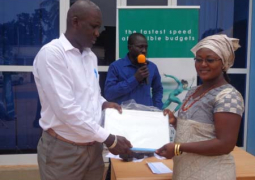World Diabetes Day raises global awareness of diabetes - it’s escalating rates around the world and how to prevent the illness in most cases.
Started by the International Diabetes Federation (IDF) and WHO, the Day is celebrated on 14 November to mark the birthday of Frederick Banting, who, along with Charles Best, was instrumental in the discovery of insulin in 1922, a life-saving treatment for diabetes patients.
WHO estimates that more than 346 million people worldwide have diabetes. This number is likely to more than double by 2030 without intervention. Almost 80% of diabetes deaths occur in low- and middle-income countries.
Dr Azadeh, a senior lecturer at the Medical School of the University of The Gambia is focusing in this issue on incurable but preventable and treatable diabetes disease and explains how to protect your health from high blood sugar level; information on diabetes causes, risk factors, warning, signs and prevention advice.
Dr Azadeh, what is diabetes and how risky is this disease for the Gambian population?
The diabetes disease, caused by high sugar level in human blood as I was talking to a friend who is a qualified psychologist and he responded to me as we were talking about this disease, as it is preventable or incurable disorder of the blood sugar in human.
In our conversation, he said I wonder why the word “sugar” is being used as the most romantic and meaningful in a loving relationship. How great will you feel if someone called you every day just to say “Hey sweetheart”. In Psychology to call someone sweetheart it means to remind you that you are missed, loved, and you are very special.
Also this impression used as sweet, sweaty for the most beautiful individual and most beautiful, expensive gifts and presents. “Why a high sugar level is being found in human blood as such harmful and become incurable disease in human biology?” And my explanation to him was as follow:
Diabetes disease in medical term is a disorder of metabolism—the way the body uses digested food for growth and energy. Most of the food people eat is broken down into glucose, the form of sugar in the blood. Glucose is the main source of fuel for the body.
After digestion, glucose passes into the bloodstream, where it is used by cells for growth and energy. For glucose to get into cells, insulin must be present. Insulin is a hormone produced by the pancreas, a large gland behind the stomach.
When people eat, the pancreas automatically produces the right amount of insulin to move glucose from blood into the cells. In people with diabetes, however, the pancreas either produces little or no insulin, or the cells do not respond appropriately to the insulin that is produced. Glucose builds up in the blood, overflows into the urine, and passes out of the body in the urine. Thus, the body loses its main source of fuel even though the blood contains large amounts of glucose.
Diagnosis of diabetes
Diabetes can often be detected by carrying out a urine test, which finds out whether excess glucose is present. This is normally backed up by a blood test, which measures blood glucose levels and can confirm if the cause of your symptoms is diabetes.
If you are worried that you may have some of the above symptoms, you are recommended to talk to your Doctor or a qualified health professional.
Increased fatigue
If your insulin is not working properly, or is not there at all, glucose will not be entering your cells and providing them with energy. This will make you feel tired and listless.
Irritability
Irritability can be due to your lack of energy.
Blurred vision
This can be caused by tissue being pulled from your eye lenses. This affects your eyes’ ability to focus. With proper treatment this can be treated. There are severe cases where blindness or prolonged vision problems can occur.
Cuts and bruises don’t heal properly or quickly
Do you find cuts and bruises take a much longer time than usual to heal? When there is more sugar (glucose) in your body, its ability to heal can be undermined.
More skin and/or yeast infections
When there is more sugar in your body, its ability to recover from infections is affected. Women with diabetes find it especially difficult to recover from bladder and vaginal infections.
Itchy skin
A feeling of itchiness on your skin is sometimes a symptom of diabetes.Gums are red and/or swollen - Gums pull away from teeth.
If your gums are tender, red and/or swollen this could be a sign of diabetes. Your teeth could become loose as the gums pull away from them.
Frequent gum disease/infection
As well as the previous gum symptoms, you may experience more frequent gum disease and/or gum infections.
Sexual dysfunction among men
If you are over 50 and experience frequent or constant sexual dysfunction (erectile dysfunction), it could be a symptom of diabetes.
Numbness or tingling, especially in your feet and hands
If there is too much sugar in your body your nerves could become damaged, as could the tiny blood vessels that feed those nerves. You may experience tingling and/or numbness in your hands and feet.
What are the types of diabetes?
The three main types of diabetes are
• Type 1 diabetes
• Type 2 diabetes
• Gestational diabetes
Type 1 Diabetes
Type 1 diabetes is an autoimmune disease. An autoimmune disease results when the body’s system for fighting infection—the immune system—turns against a part of the body. In diabetes, the immune system attacks and destroys the insulin-producing cells in the pancreas. The pancreas then produces little or no insulin. A person who has type 1 diabetes must take insulin daily to live for the rest of his or her life.
Symptoms of type 1 diabetes usually develop over a short period, although better cell destruction can begin years earlier. Symptoms may include increased thirst and urination, constant hunger, weight loss, blurred vision, and extreme fatigue. If not diagnosed and treated with insulin, a person with type 1 diabetes can lapse into a life-threatening diabetic coma, also known as diabetic death.
Type 2 Diabetes
The most common form of diabetes is type 2 diabetes. About 90 to 95 percent of people with diabetes have type 2. This form of diabetes is most often associated with older age, obesity, family history of diabetes, previous history of gestational diabetes, physical inactivity, and certain ethnicity’s. About 80 percent of people with type 2 diabetes are overweight.
Type 2 diabetes is increasingly being diagnosed in children and adolescents, especially among African-American, Mexican-American, and Pacific Islander youth.
The symptoms of type 2 diabetes develop gradually. Their onset is not as sudden as in type 1 diabetes. Symptoms may include fatigue, frequent urination, increased thirst and hunger, weight loss, blurred vision, and slow healing of wounds or sores. Some people have no symptoms.
Gestational Diabetes
Some women develop gestational diabetes late in pregnancy. Although this form of diabetes usually disappears after the birth of the baby, women who have had gestational diabetes have a 40 to 60 percent chance of developing type 2 diabetes within 5 to 10 years. Maintaining a reasonable body weight and being physically active may help prevent development of type 2 diabetes.
How is diabetes diagnosed?
The fasting blood glucose test is the preferred test for diagnosing diabetes in children and non-pregnant adults. The test is most reliable when done in the morning. However, a diagnosis of diabetes can be made based on any of the following test results, confirmed by retesting on a different day:
• A blood glucose level of higher after an 8-hour fast. This test is called the fasting blood glucose test.
• A random—taken at any time of day—blood glucose level of 200 mg/dL or higher, along with the presence of diabetes symptoms.
What are the scope and impact of diabetes?
Diabetes is widely recognised as one of the leading causes of death and disability in the world and also in The Gambia. In 2006, it was the seventh leading cause of death. However, diabetes is likely to be under reported as the underlying cause of death on death certificates.
Diabetes is associated with long-term complications that affect almost every part of the body. The disease often leads to blindness, heart and blood vessel disease, stroke, kidney failure, amputations, and nerve damage. Uncontrolled diabetes can complicate pregnancy, and birth defects are more common in babies born to women with diabetes.
Who gets diabetes?
Diabetes is not contagious. People cannot “catch” it from each other. However, certain factors can increase the risk of developing diabetes.
Type 1 diabetes occurs equally among males and females but is more common in whites than in nonwhites. Data from the World Health Organisation’s Multinational Project for Childhood Diabetes indicate that type 1 diabetes is rare in most African, American Indian, and Asian populations.
However, some northern European countries, including Finland and Sweden, have high rates of type 1 diabetes. The reasons for these differences are unknown. Type 1 diabetes develops most often in children but can occur at any age.
Type 2 diabetes is more common in older people, especially in people who are overweight, and occurs more often in African-Americans, American-Indians, some Asian-Americans, Native Hawaiians and other Pacific Islander Americans, and Hispanics/Latinos. National survey data in 2007 indicate a range in the prevalence of diagnosed and undiagnosed diabetes in various populations ages 20 years or older:
How is diabetes managed?
Healthy eating, physical activity, and blood glucose testing are the basic management tools for type 2 diabetes. In addition, many people with type 2 diabetes require one or more diabetes medicines—pills, insulin, and other inject able medicine—to control their blood glucose levels.
Adults with diabetes are at high risk for cardiovascular disease (CVD). In fact, at least 65 percent of those with diabetes die from heart disease or stroke. Managing diabetes is more than keeping blood glucose levels under control—it is also important to manage blood pressure and cholesterol levels through healthy eating, physical activity, and the use of medications, if needed. By doing so, those with diabetes can lower their risk. Aspirin therapy, if recommended by a person’s health care team and smoking cessation can also help lower risk.
People with diabetes must take responsibility for their day-to-day care. Much of the daily care involves keeping blood glucose levels from going too low or too high. When blood glucose levels drop too low—a condition known as hypoglycemia—a person can become nervous, shaky, and confused. Judgement can be impaired, and if blood glucose falls too low, fainting can occur.
DR Azadeh where in The Gambia people can go for check up and get diagnosed?
Fortunately in most public and private health facilities, Hospitals, health centres throughout the country having facilities for diagnose, treatment and advice on diabetes, also getting information from “Diabetes Association in Gambia”, E-mail (mail@ diabetesgambia.org), The Point Newspaper, call West Cost Radio, DR Azadeh and Peter Gomez live Health Show every Tuesday from 6-7pm, E- mail azadehhasan@yahoo.co.uk or call DR AZADEH TEL. 7774469/3774469 working days only from 3-6pm.



